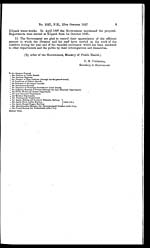Medicine - Institutions > Reports from medical colleges, schools and research institutions > Report of the King Institute of Preventive Medicine, Guindy > Report of the King Institute of Preventive Medicine Guindy for the year ending 31st March 1927
(323) Page 2
Download files
Individual page:
Thumbnail gallery: Grid view | List view

2
No. 2127, P.H., 27TH OCTOBER 1927
increase in the number of Wassermann tests made is attributed partly to the
investigation into the prevalence of venereal disease among the population carried
out for the information of the Delegation of the British Social Hygiene Council.
5. The Public Analyst continued to control the chemical side of the work of
the Public Health section of the Institute during the year. The Madras Preven-
tion of Adulteration Act, 1918, has not yet been brought into force, and there was
therefore no regular supply of food samples for analysis, but a number of such
samples were examined in connexion with various investigations. The question
of extending the Act to certain selected municipalities is engaging the attention
of the Government, and it is hoped that during the next official year the Act will
be in force in the most important towns in the Presidency. The results of treat-
ing cancer with a preparation of lead which the Public Analyst has succeeded in
stabilizing by a method not previously applied, may be of the greatest importance,
and are awaited with interest.
6. The investigation units attached to the Institute continued to perform
valuable work in connexion with malaria surveys and other special investigations.
7. In addition to the routine examination of samples of water obtained from
the protected water-supplies in municipalities, an unusually large number of
special investigations in connexion with water-supply were carried out in various
parts of the Presidency during the year under report. A new arrangement was
introduced during the year, under which only a general report on the examination
of water-supplies was sent direct to the local bodies concerned, specific recom-
mendations for the improvement of the water-works being sent to the Sanitary
Engineer and the Director of Public Health in order to enable them to advise
the authorities concerned as to the measures to be taken to rectify the defects
brought to light.
8. The attention of the Inspector-General of Prisons is invited to the
remarks made in the report on the impurity of the water-supply of all the jails
except that at Rajahmundry.
9. In order to ensure that good drinking water is supplied to railway
passengers the Government in 1918, on the recommendation of the Sanitary
Commissioner, ordered that the water supplied at seventeen railway stations should
be periodically analysed at the King Institute, and in April 1927 they accepted the
Surgeon-General’s proposals for the examination of the water supplied at twenty-
nine other railway stations. An examination of the water supplied at the railway
stations at Pākāla and Tanjore and from the well near the pumping shed at Waltair
showed that the supply was badly polluted. The Agents of the railway adminis-
trations concerned will be requested to have necessary steps taken in order to
improve the quality of the water supplied at these stations.
10. The Director reports that, owing to a lack of first-hand knowledge of
local conditions, it has often been found difficult in the past to suggest the reason
for an unsatisfactory supply or to recommend suitable remedial measures to
improve it and that to obtain the required information a survey of the water-
supplies in the Presidency is therefore being undertaken. The Government await
the results of the survey.
11. The experiments started in 1925-26 regarding the value of a percolating
non-submerged filter compared with an ordinary submerged slow sand filter were
continued during the year under report, and were not complete by the end of the
year. The Government await with interest the results of the experiments.
12. Since 1913 experiments on the purification of water for public water-
supplies have been carried out at the Institute. The value of the experiments
have, however, been limited owing to the fact that they were carried out with
only one water, namely, that of the Adyar River. The Committee on Water and
Sewage Purification recommended in 1926 that the experiments should be repeated
on another water and that for that purpose a plant should be erected at the
Set display mode to: Large image | Zoom image | Transcription
Images and transcriptions on this page, including medium image downloads, may be used under the Creative Commons Attribution 4.0 International Licence unless otherwise stated. ![]()
| Permanent URL | https://digital.nls.uk/74937273 |
|---|
| Description | 13 titles. Describes research work and conditions, treatments, vaccine production, medical education, public health and disease outbreaks. Extensive tables show mortality rates and patient admissions. These - some from asylums, jails, dispensaries, civil and police hospitals – will be useful to epidemiologists. |
|---|



![[Page 1]](https://deriv.nls.uk/dcn4/7493/74937272.4.jpg)
